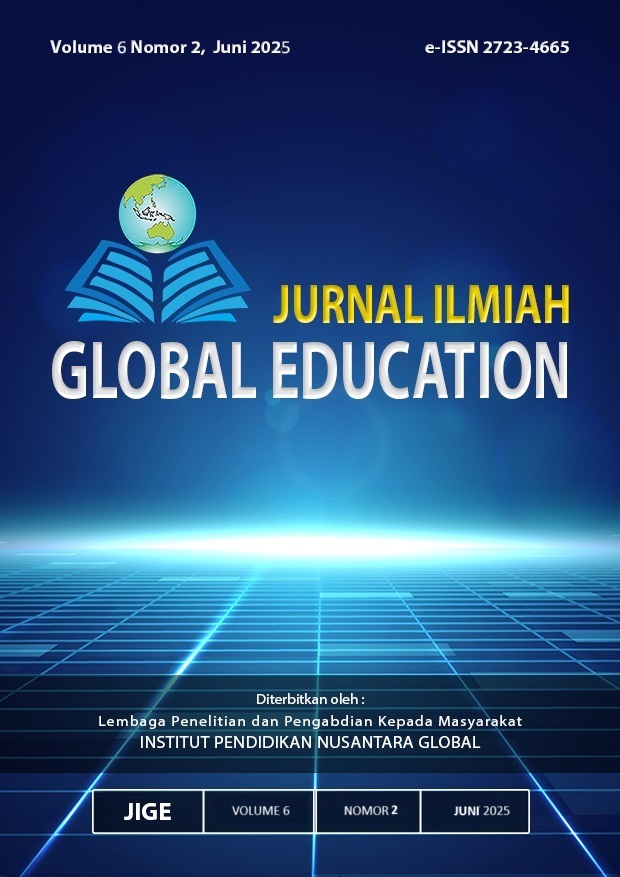Pengembangan E-Book untuk Meningkatkan Kemampuan Peserta Didik dalam Membuat Puff Pastry
DOI:
https://doi.org/10.55681/jige.v6i2.3760Keywords:
E-Book, Flipbook, Puff Pastry, Interactive Learning, Educational TechnologyAbstract
This research and development study aims to produce an E-Book learning material using the Flipbook Maker application that is feasible, practical, and effective in enhancing students' skills in making puff pastry. This study follows the ADDIE development model, which consists of five stages: (1) the Analysis stage to conduct a preliminary study, (2) the Design stage to develop the e-book, (3) the Development stage to refine the e-book and validate it with experts, (4) the Implementation stage to conduct user trials, and (5) the Evaluation stage to assess and improve the quality of the e-book. The research findings indicate: (1) Validation by instructional material experts classified the puff pastry e-book as highly feasible, with an average score of 95.14%. (2) Validation by media experts also classified it as highly feasible, with an average score of 90.97%. (3) Validation by instructional design experts rated it as highly feasible, with an average score of 96.35%. (4) Individual trials categorized it as highly feasible, with an average score of 88.83%. (5) Small group trials also placed it in the highly feasible category, with an average score of 85.45%. (6) Field trials classified it as very good, with an average score of 86.24%. The practicality test conducted by subject teachers resulted in an average score of 91.67% (highly practical), while the student practicality test scored an average of 94.24% (highly practical). The effectiveness test of students' practical skills in making puff pastry showed that students in the experimental class who used the e-book puff pastry achieved an average practical score of 37.7, whereas students in the control class who used printed book obtained an average score of 35. The normality test results for the experimental class indicated that χ²calculated < χ²table (5.02 < 11.07), and for the control class, χ²calculated < χ²table (2.68 < 11.07), suggesting a normal distribution at a 5% significance level. The homogeneity test showed that Fcalculated < Ftable (0.99 < 4.14), indicating that the data distribution was homogeneous. The hypothesis test using an Independent t-test resulted in tcalculated > ttable (7.8 > 1.9), leading to the rejection of Ho and acceptance of Ha. This indicates that there is a significant difference in the practical results of students using the E-Book Puff Pastry in the experimental class compared to the practical results of students using printed books in the control class of Grade XI Culinary Arts at SMK Negeri 8 Medan.
Downloads
References
Amaliah, A., Adnan, A., & Azis, A. A. (2022). Pengembangan E-Book Berbasis Studi Kasus Pada Materi Perubahan Lingkungan Kelas X SMA. BIOSFER: Jurnal Biologi Dan Pendidikan Biologi, 7(1), 1–13.
Awwaliyah, H, S., Ahmad, M. (2021). Pengembangan E-Modul Berbasis Flipbook Untuk Meningkatkan Motivasi Belajar Siswa SMP Tema Cahaya, Indonesia Journal of Science Education (IJNSE). 4(2).
Dewi, Q. (2023). Hubungan Efikasi Diri dan Regulasi Diri dengan Hasil Belajar Biologi Siswa Kelas XI MIPA di MAN 1 Jember Tahun Pelajaran 2022/2023. Universitas Islam Negeri Kiai Haji Achmad Siddiq Jember.
Fitriani, N. (2023). Penggembangan Modul Merdeka Belajar Matematika Berformat Flipbook Untuk Meningkatkan Penalaran Kritis Dan Kemandirian Siswa SMP. Jurnal Program Studi Pendidikan Matematika, 12(1), 1286–1296.
Hasibuan, A. T., & Prastowo, A. (2019). Konsep Pendidikan Abad 21: Kepemimpinan Dan Pengembangan Sumber Daya Manusia Sd/Mi. Media Pengembangan Ilmu Pendidikan Dasar Dan Keislaman, 10(1), 26–50.
Karimah, S. (2021). Meningkatkan Kemandirian Dan Hasil Belajar Peserta Didik Menggunakan Kvisoft Flipbook Maker Berbasis Android. Jurnal Ekonomi, Bisnis Dan Pendidikan, 1(6), 538–545.
Nasution. (2018). Pentingnya Literasi Teknologi Bagi Mahasiswa Calon Guru Matematika. Jurnal Kajian Pembelajaran Matematika, 2(1), 1–13.
Nora, Malawi, I., & Suyanti. (2023). Pengembangan Bahan Ajar berbasis Flipbook untuk Meningkatkan Motivasi dan Hasil Belajar Siswa Kelas V SDN 04 Madiun Lor. Jurnal Universitas PGRI Madiun, 4(1), 112–120.
Prastowo Adi. (2015). Panduan Kreatif Membuat Bahan Ajar Inovatif. Jogjakarta: DIVA Press.
Robbia, A. Z., & Fuadi, H. (2020). Pengembangan Keterampilan Multimedia Interaktif Pembelajaran IPA Untuk Meningkatkan Literasi Sains Peserta Didik di Abad 21. Jurnal Ilmiah Profesi Pendidikan, 5(2), 117–123.
Santoso, H. B., Schrepp, M., & Isal, R. Y. K. (2016). Measuring User Experience Of The Student-Centered E-Learning Environment. Journal of Educators Online, 13(1), 1–13.
Siregar, N., Warsito, W., & Gumilar, A. (2024). STEM in action: real-world applications of science, technology, engineering, and math. Jurnal Pendidikan Matematika2, 8(2), 493–507.
Sugiyono. (2018). Metode Penelitian Kuantitatif, Kualitatif, dan R&D. Bandung: Alfabeta.
Sugiyono. (2019). Metode Penelitian Kuantitatif, Kualitatif dan R&D (2nd ed.).
Suwarni. (2015). Pengembangan Media Pembelajaran Berbasis Buku Elektronik Pada Sistem Imun. Jurnal Matematika Dan Pengetahuan Alam, 2(1), 1–13.
Wibowo, E., & Pratiwi, D. D. (2018). Pengembangan Bahan Ajar Menggunakan Aplikasi Kvisoft Flipbook Maker Materi Himpunan Desimal. Jurnal Matematika, 1(2), 147–154.
Yustika, Ni Awan Sri. (2019). Pentingnya Sarana Pendidikan Dalam Menunjang Kualitas Pendidikan Di Sekolah. Jurnal penididkan hindu.
Zaqiah, Q. Y., Erihadiana, M., & Muhammad, G. (2021). Kecakapan Guru Pendidikan Agama Islam dalam Mengoptimalkan Pembelajaran Berbasis Teknologi. Jurnal Pendidikan Agama Islam Al-Thariqah, 6(1), 1–14.
Downloads
Published
How to Cite
Issue
Section
License
Copyright (c) 2025 Tri Anita Nasution, Dina Ampera, Farihah

This work is licensed under a Creative Commons Attribution-ShareAlike 4.0 International License.












